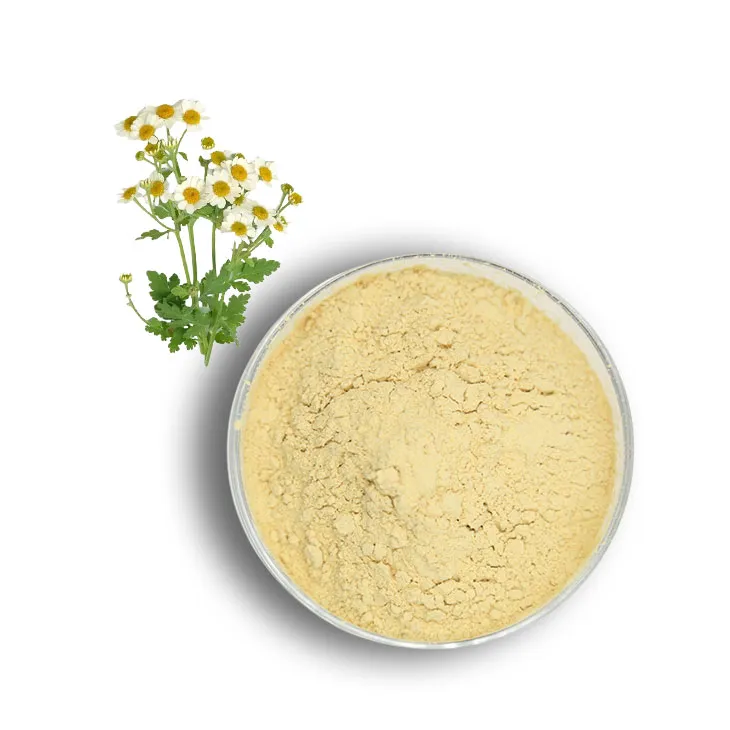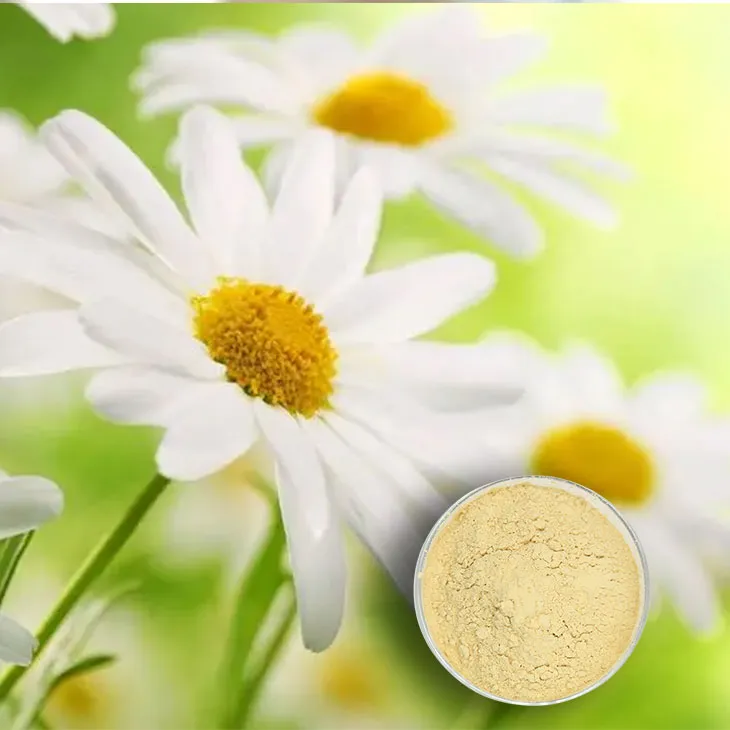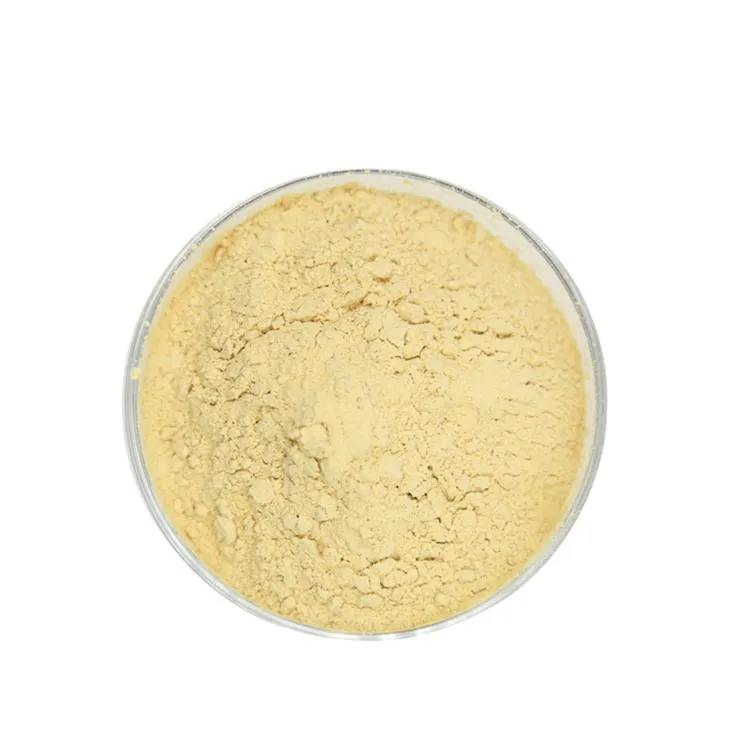- 0086-571-85302990
- sales@greenskybio.com
Organic Supercritical CO₂ Extraction of Feverfew Extracts
2024-11-28

1. Introduction
Supercritical CO2 extraction of organic Feverfew Extract has emerged as a highly innovative and significant technique in recent years. Feverfew (Tanacetum parthenium), a herbaceous plant native to certain regions of Europe and Asia, has been used in traditional medicine for centuries. Its potential health benefits, including anti - inflammatory, analgesic, and antipyretic properties, have attracted the attention of modern scientific research. Supercritical fluid extraction, with CO2 as the supercritical fluid, offers a novel and efficient means to isolate and purify the valuable components from feverfew.

2. Supercritical CO₂: Properties and Advantages
Supercritical CO2 is a state of carbon dioxide where it exhibits unique properties that make it an ideal solvent for extraction. It has the gas - like diffusivity, which allows it to penetrate rapidly into the matrix of the feverfew plant material. At the same time, it has a liquid - like density, enabling it to dissolve a wide range of compounds effectively.
One of the major advantages of using supercritical CO2 is its environmental friendliness. CO2 is a non - toxic, non - flammable gas that is readily available and relatively inexpensive. Moreover, in comparison to traditional organic solvents, supercritical CO2 extraction leaves no harmful residues in the final extract. This is of great importance, especially when the extract is intended for applications in the food, cosmetic, or pharmaceutical industries where purity and safety are crucial requirements.

3. Feverfew: A Valuable Source of Bioactive Compounds
Feverfew contains a rich array of bioactive compounds. Parthenolide, a sesquiterpene lactone, is considered one of the most important and characteristic components of feverfew. It has been shown to possess significant anti - inflammatory activity by inhibiting the production of inflammatory mediators such as prostaglandins and leukotrienes. Additionally, feverfew also contains flavonoids, phenolic acids, and other terpenoids, which may contribute to its overall pharmacological effects.
Research on feverfew has been expanding in recent years. Scientists are constantly exploring its potential applications in various fields. For example, in the medical field, it is being investigated for its possible role in treating migraines, arthritis, and other inflammatory - related diseases. In the cosmetic industry, its antioxidant and anti - inflammatory properties make it a potential ingredient for skincare products aimed at reducing inflammation, soothing the skin, and preventing premature aging.

4. The Supercritical CO₂ Extraction Process
4.1. Equipment Setup
The supercritical CO2 extraction system typically consists of a CO2 source, a pump to pressurize the CO2, an extraction vessel where the feverfew plant material is placed, a separator to separate the extract from the CO2, and a temperature - control unit. The extraction vessel is designed to withstand high pressures and is usually made of stainless steel to ensure compatibility with the CO2 and the plant material.
4.2. Influence of Parameters
Several parameters play crucial roles in the supercritical CO2 extraction of Feverfew Extracts.
- Pressure: The pressure has a significant impact on the solubility of the compounds in CO2. Generally, as the pressure increases, the solubility of the bioactive compounds in feverfew also increases. However, there is an optimal pressure range beyond which further increases may not lead to significant improvements in extraction efficiency.
- Temperature: Temperature affects both the density of the supercritical CO2 and the volatility of the compounds in feverfew. Higher temperatures can increase the diffusivity of CO2 but may also cause degradation of some heat - sensitive compounds. Therefore, a careful balance needs to be struck when selecting the extraction temperature.
- Extraction Time: The extraction time determines the amount of extract that can be obtained. Longer extraction times may result in higher yields, but it may also increase the cost and the risk of extracting unwanted compounds. Optimizing the extraction time is essential to obtain a high - quality extract with maximum efficiency.

5. Quality and Characteristics of the Extract
The extract obtained through supercritical CO2 extraction of feverfew has several notable characteristics. Firstly, it has a high concentration of active ingredients due to the selective extraction capabilities of supercritical CO2. This means that a relatively small amount of the extract can potentially have a significant biological effect. Secondly, the extract is free from harmful solvent residues, which enhances its safety and suitability for various applications.
The quality of the extract can be further analyzed and characterized using various techniques. High - performance liquid chromatography (HPLC) can be used to identify and quantify the different bioactive compounds present in the extract. Gas chromatography - mass spectrometry (GC - MS) can also be employed, especially for analyzing volatile components. These analytical techniques help in ensuring the consistency and quality of the extract, which is essential for its commercialization and application in different industries.

6. Comparison with Conventional Extraction Methods
Supercritical CO2 extraction offers several advantages over conventional extraction methods when it comes to Feverfew Extraction.
- Shorter Extraction Times: In comparison to methods such as Soxhlet extraction or maceration, supercritical CO2 extraction can often achieve comparable or even higher yields in a much shorter time. This is due to the efficient mass transfer properties of supercritical CO2.
- Lower Energy Consumption: The process of supercritical CO2 extraction generally requires less energy compared to traditional extraction methods. This is because the CO2 can be recycled within the system, and the extraction process can be optimized to reduce energy waste.
- No Residue of Harmful Solvents: Conventional extraction methods often rely on organic solvents such as ethanol, hexane, or chloroform. These solvents may leave residues in the extract, which can be a concern, especially for applications in the food and pharmaceutical industries. Supercritical CO2 extraction, on the other hand, does not have this problem as CO2 is a clean and non - toxic solvent.
7. Applications in Different Industries
7.1. Medical Applications
The anti - inflammatory and other potential therapeutic effects of feverfew make its extract a promising candidate for medical applications. For example, in the treatment of migraines, some studies have suggested that feverfew extract may help reduce the frequency and severity of migraine attacks. In arthritis, its anti - inflammatory properties could potentially be used to relieve joint pain and inflammation. However, further research is still needed to fully understand the mechanisms of action and to establish its efficacy and safety in clinical settings.
7.2. Cosmetic Applications
In the cosmetic industry, feverfew extract can be used in various skincare products. Its antioxidant properties can help protect the skin from oxidative stress, which is associated with premature aging. The anti - inflammatory properties can also be beneficial for treating skin conditions such as acne, eczema, and rosacea. It can be incorporated into creams, lotions, serums, and masks to provide soothing and anti - aging effects.
7.3. Food Applications
Feverfew extract may also find applications in the food industry. It could potentially be used as a natural preservative due to its antioxidant and antimicrobial properties. Additionally, it may be added to functional foods or dietary supplements as a source of bioactive compounds for promoting health and well - being. However, regulatory requirements need to be met to ensure its safety for consumption.
8. Conclusion
Supercritical CO2 extraction of organic feverfew extract is a highly promising technique. It combines the unique properties of supercritical CO2 with the valuable bioactive compounds present in feverfew. This method offers numerous advantages over conventional extraction methods, including shorter extraction times, lower energy consumption, and the absence of harmful solvent residues. The extract obtained has a high concentration of active ingredients and can be used in various industries such as medicine, cosmetics, and food. However, further research is still required to optimize the extraction process, fully understand the biological activities of the extract, and ensure its safety and efficacy in different applications.
FAQ:
What are the advantages of supercritical CO₂ extraction for feverfew extracts?
Supercritical CO₂ extraction for feverfew extracts has several advantages. Firstly, supercritical CO₂ has gas - like diffusivity and liquid - like density, enabling it to penetrate deep into the feverfew plant material. Secondly, compared to conventional extraction methods, it has shorter extraction times, lower energy consumption, and no residue of harmful solvents. Also, this method is highly reproducible and can be optimized by adjusting parameters such as pressure, temperature, and extraction time.
What kind of bioactive compounds can be found in feverfew?
Feverfew is rich in bioactive compounds, but specific ones include various substances that are of great interest in research. These compounds are associated with its potential anti - inflammatory and other therapeutic effects, although the exact composition and their individual functions are still the subject of much research.
How can the supercritical CO₂ extraction of feverfew be optimized?
The supercritical CO₂ extraction of feverfew can be optimized by adjusting parameters such as pressure, temperature, and extraction time. By carefully controlling these factors, one can achieve the highest concentration of active ingredients in the extract and ensure the reproducibility of the extraction process.
What are the potential applications of feverfew extract obtained by supercritical CO₂ extraction?
The feverfew extract obtained by supercritical CO₂ extraction has potential applications in medicine, due to its anti - inflammatory and other potential therapeutic effects. It can also be used in the cosmetic and food industries. In medicine, it may be developed into drugs or supplements. In cosmetics, it could be used for its skin - beneficial properties, and in the food industry, it may be added as a natural ingredient with certain health - promoting effects.
Why is supercritical CO₂ a good solvent for feverfew extraction?
Supercritical CO₂ is a good solvent for feverfew extraction because it has gas - like diffusivity and liquid - like density. This unique property allows it to effectively penetrate the feverfew plant material and extract the valuable bioactive compounds. Additionally, it leaves no residue of harmful solvents, which is important for the purity and safety of the final extract.
Related literature
- Title: Supercritical Fluid Extraction of Bioactive Compounds from Feverfew: A Comprehensive Review"
- Title: "Optimization of Supercritical CO₂ Extraction of Feverfew for Medicinal Applications"
- Title: "The Role of Feverfew Extracts in Cosmetics: Insights from Supercritical CO₂ Extraction"
- ▶ Hesperidin
- ▶ citrus bioflavonoids
- ▶ plant extract
- ▶ lycopene
- ▶ Diosmin
- ▶ Grape seed extract
- ▶ Sea buckthorn Juice Powder
- ▶ Beetroot powder
- ▶ Hops Extract
- ▶ Artichoke Extract
- ▶ Reishi mushroom extract
- ▶ Astaxanthin
- ▶ Green Tea Extract
- ▶ Curcumin Extract
- ▶ Horse Chestnut Extract
- ▶ Other Problems
- ▶ Boswellia Serrata Extract
- ▶ Resveratrol Extract
- ▶ Marigold Extract
- ▶ Grape Leaf Extract
- ▶ blog3
- ▶ blog4
-
High - quality Chasteberry Extract Products.
2024-11-28
-
China's banana juice powder suppliers.
2024-11-28
-
Bulk purchase of cranberry extract.
2024-11-28
-
How to make powder with bayberry extract?
2024-11-28
-
The best peony root extract in nature.
2024-11-28
-
100% Pure Organic Baicalin.
2024-11-28
-
Okra Extract
2024-11-28
-
Honeysuckle Pollen
2024-11-28
-
Tamarind extract powder
2024-11-28
-
Propolis Extract Powder
2024-11-28
-
Black Garlic Extract
2024-11-28
-
Resveratrol extract
2024-11-28
-
Longan Extract
2024-11-28
-
Red Wine Extract
2024-11-28
-
Nettle Root Extract
2024-11-28
-
Lemon Balm Extract
2024-11-28





















